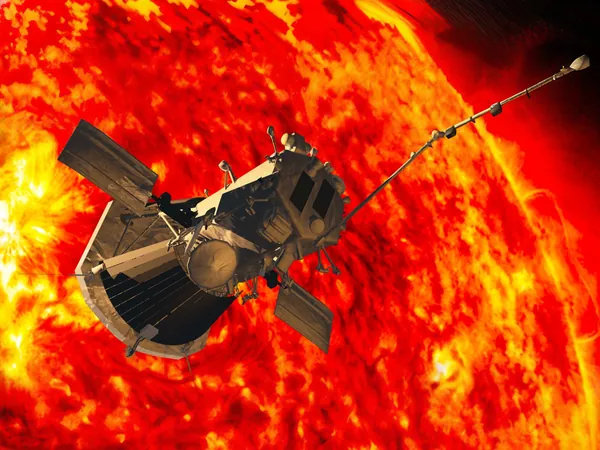
Parker Solar Probe Makes History by Approaching the Sun Closer Than Ever!
2024-12-28
Author: William
NASA's Parker Solar Probe Makes History
NASA's Parker Solar Probe has accomplished an extraordinary milestone, edging closer to the Sun than any spacecraft in history. On December 24, 2024, the probe skimmed just 3.8 million miles from the Sun’s scorching surface, a feat that will transform our understanding of solar physics.
With its remarkable speed of 430,000 miles per hour, the Parker Solar Probe holds the title of the fastest human-made object. Just two days after its record-breaking approach, a beacon tone was received on December 26, confirming the probe's operational status—this pivotal moment signifies a major advance in space exploration.
A Groundbreaking Mission to "Touch" a Star
This historic mission, dubbed humanity's first attempt to "touch" a star, has profound implications for our comprehension of the solar system. Nicky Fox, the Science Mission Directorate leader at NASA, emphasized the significance, stating, "Flying this close to the Sun is a historic moment in humanity’s first mission to a star." The data collected is anticipated to shed light on the Sun's influence on the space environment, including its effects on Earth’s technology.
The Parker Solar Probe’s Incredible Journey
Launched in 2018, the Parker Solar Probe has taken a strategic path, utilizing seven flybys of Venus to adjust its trajectory and navigate closer to the Sun. Its final flyby of Venus on November 6, 2024, positioned the spacecraft optimally for its intense solar observations. This carefully orchestrated orbit allows the probe to make critical measurements every three months while carefully managing exposure to extreme solar radiation.
Engineering Triumph: Surviving Extreme Temperatures
Operating in the Sun’s corona, where temperatures can exceed 1 million degrees Fahrenheit, the Parker Solar Probe utilizes a state-of-the-art carbon foam shield to protect its instruments. This innovative shield withstands temperatures up to 2,600 degrees Fahrenheit, ensuring that the onboard technology remains operational and safe.
John Wirzburger, a mission systems engineer at the Johns Hopkins Applied Physics Laboratory (APL), remarked, "It’s monumental to be able to get a spacecraft this close to the Sun." This achievement is a testament to decades of technological progress made since the initial challenges were first identified in 1958.
Redefining Solar Science and Uncovering Mysteries
The Parker Solar Probe is revolutionizing our understanding of solar science by gathering unprecedented data on solar phenomena. Scientists aim to unravel long-standing mysteries, including the reasons behind the high temperatures of the corona and the generation of solar wind.
Kelly Korreck, a heliophysicist at NASA, highlighted the significance of these findings: "The data is so important for the science community because it gives us another vantage point." Initial observations have already unveiled unexpected features in the corona and provided insights into the origins of switchbacks in the solar wind, phenomena that have puzzled scientists for decades.
Discoveries Extending Beyond the Sun
Beyond solar observations, Parker Solar Probe has made insightful discoveries about the inner solar system. It found that coronal mass ejections (CMEs) behave like massive vacuums, collecting dust particles in their explosive paths. Understanding these interactions enhances our knowledge of how solar events shape the environment between planets.
Furthermore, during its close encounters with Venus, the probe detected natural radio emissions from the planet's atmosphere and captured the first complete image of Venus's dust ring. These findings contribute significantly to our understanding of Venusian atmospheric conditions.
Exciting Data on the Way!
As data from the probe’s recent solar pass is prepared for transmission back to Earth, experts are eagerly anticipating the fresh insights it will offer. Joe Westlake, NASA's Heliophysics Division director, declared, "The data that will come down from the spacecraft will be fresh information about a place that we, as humanity, have never been."
With additional close approaches scheduled for March 22 and June 19, 2025, the Parker Solar Probe is set to deepen our understanding of the Sun and its pervasive influence on the solar system, heralding a new era in our quest to decode the universe's greatest mysteries.
Stay tuned for more thrilling updates and insights from this groundbreaking mission!



 Brasil (PT)
Brasil (PT)
 Canada (EN)
Canada (EN)
 Chile (ES)
Chile (ES)
 Česko (CS)
Česko (CS)
 대한민국 (KO)
대한민국 (KO)
 España (ES)
España (ES)
 France (FR)
France (FR)
 Hong Kong (EN)
Hong Kong (EN)
 Italia (IT)
Italia (IT)
 日本 (JA)
日本 (JA)
 Magyarország (HU)
Magyarország (HU)
 Norge (NO)
Norge (NO)
 Polska (PL)
Polska (PL)
 Schweiz (DE)
Schweiz (DE)
 Singapore (EN)
Singapore (EN)
 Sverige (SV)
Sverige (SV)
 Suomi (FI)
Suomi (FI)
 Türkiye (TR)
Türkiye (TR)
 الإمارات العربية المتحدة (AR)
الإمارات العربية المتحدة (AR)